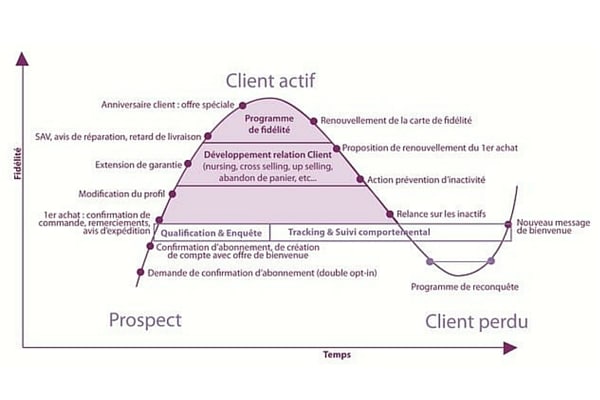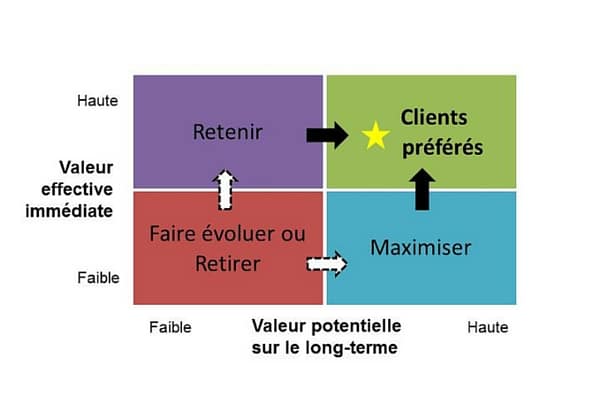Retention. You will often hear that it costs less than acquisition. “It’s always easier to sell a chocolate bar to someone who already buys 20 kilos a year than to someone who doesn’t buy any. Let’s say that it will allow you to generate more revenue.
The life cycle of your customers has a beginning and an end, just like in any book. The idea is to engage and prevent customer inactivity.
A loyalty program is a good way to play on these two levers. And let’s not forget that the life cycle is shorter now with the web. Your customer is constantly solicited by your competitors.

The customer life cycle – source : definitons-marketing.com
Loyalty programs: business model.
The loyalty program comes into play after the first purchase. It serves to engage the customer with the objective that he will renew his purchases with your company (and not another one).
After-sales service is a part of a loyalty program, just like relationship marketing programs.
Traditionally, most loyalty programs are based on a transactional model: you offer points that have a monetary value. This is a model that all loyalty programs use today.
The principle? You spend, you earn points and most of the time you will use these points or promotional offers to reduce your bill on a next purchase.
As each retailer now has its own loyalty program, it is quite difficult to differentiate yourself with this one tool.
Classical segmentation models
The Life Time Value
Let’s try to broaden our vision and go beyond this transactional model.
A first approach is to use the “life time value” which tries to position each customer on two axes: the immediate profit generated by this customer and its long-term potential.
This allows us to differentiate them into four categories: those we want to maximize, get out, keep and the preferred ones.

The Life-Time Value model. Source : Shaw & Stone (1988), Database Marketing.
Each quadrant in the matrix indicates the action to be taken with respect to the customer to improve profitability.
- Preferred customers, as their name indicates, are the premium customers to be “pampered” and retained.
- On the other hand, customers to be withdrawn have little effective value for the company and little potential in the long term. The strategy is to move them into one of the two categories Maximize or Retain, otherwise, to exclude them.
- Retain customers, even if they don’t have much long-term potential, bring in high immediate revenues and can thus be used to invest in high-potential customers. The strategy is to try to move them into the “Preferred Customers” category.
- Finally, these are the famous clients to maximize for which you should start investing now because they will bring higher revenues in the long run. The strategy is also to try to move them into the “Preferred Customers” category.
Life time value allows you to value some of your clients who are not profitable today but who will become so in the future.
This is typically the student at the end of his or her studies who is about to enter the job market, who is favored by all banks.
The disadvantage of this segmentation is that it is based on the transaction and does not take into account the customer journey and their interactions.
We can then add a scoring system that allows us to classify customers according to different characteristics by assigning them a “score“.
The RFM scoring model
RFM scoring is based on a model of recency and frequency of contact with your customers and the amount of their purchases.
- The recency criterion measures the time elapsed since the last recorded exchange with the customer, the last time the latter was interested in the company, its products or services.
- The frequency corresponds to the total number of exchanges over a given period (the current year, for example). It is often with this criterion that we realize that keeping a customer is often more difficult than finding a new one.
- The amount is the total amount spent by the customer over the whole period analyzed.
The methodology of this scoring is defined by each company. A high customer score means that your customer is loyal. It is therefore important to pamper them, to offer them additional services in order to give them a special experience.
A simple example: To assign a RFM score, you can simply use a rating scale from 1 to 10 for each criterion.
Recency: The rating can be established from 1 to 10 according to the date of the last customer return. The value 10 could correspond to a last return in the previous month, 9 for a return 2 months ago, 8 for the last quarter etc.
Frequency: Here you can quantify the number of contacts made during the current year. From a score of 1 for a single contact in the last 12 months to a score of 10 for more than 10 contacts in the last 12 months.
Amount: Finally, in the same way, a score of 10 can be given for an amount of more than 1000€ generated in the last 12 months and conversely a score of 1 for an amount of less than 10€.
One of the advantages for the sales teams is that they can quickly evaluate the interest of the customer and their chances of making a sale with him thanks to this score.
In conclusion, even if this segmentation is based more on the customer journey, it remains rather imprecise as to the “quality” and types of interactions experienced with the customer.
It does not allow for the weighting of different interactions: a visit to a blog does not count as much as a webinar registration! The criteria of recency and frequency are not enough to properly evaluate the interest of a prospect. You need to be more interested in someone who wants to register for a webinar than in someone who has only visited a blog two or three times.
RFM scoring alone will automatically give a higher score to several blog visits than to a single visit (even if this visit leads to a registration)…
Behavioral valuation and social influence
It is not only the turnover or profit generated by your customers that should be taken into account, but also the ability of your customers to influence others and their behavior.
The social dimension is an important element to take into account. A person who does not consume your product often but who often praises it to his 500 followers or friends deserves special attention because he is likely to drain more revenue than a person who consumes a lot but does not talk about it.
Likewise, a person who brings in money by his attitude should also be rewarded. This could be a person who does not want to have unlimited drinks in a restaurant, or a person who does not want his or her towels cleaned every day for a hotel. You save money THROUGH your customer’s behavior.
Although these two elements are important, they are not taken into account in the calculation of the Life Time Value or in the RFM scoring.
Tomorrow’s loyalty programs
Today, all companies have a loyalty program. How many cards do you have in your wallet?
Loyalty programs today have to be innovative. It’s no longer enough to offer discounts or deals. Your loyalty program must be an integral part of the customer experience.
You have to make your customer dream to activate and engage them.
Many players are starting to realize this new challenge.
Innovation in terms of rewards is key. The transactional reward model has been overused.
We now need to move to a customer experience based reward model.
One airline industry player decided to ask a simple question on their forum: “How would you like to be rewarded for your loyalty?”
The answers ?
- “Greet the pilot”
- “Visit the cockpit of the plane”
- “Talk into the megaphone”
As you can see, all these proposals have one thing in common: the experience.
No, your customers are not only looking for discount coupons, but to live with you an experience that is sometimes funny, above all enriching and if possible unique and moving.
Do you know the story of Sophie the Giraffe at the Hilton Hotel? A daddy had forgotten his daughter’s toy (oh my…). The hotel employees then scripted Sophie’s vacation to explain her absence through a photo album. And all’s well that ends well… because we almost had a catastrophe.
You now have all the cards in your hand… so it’s up to you!






